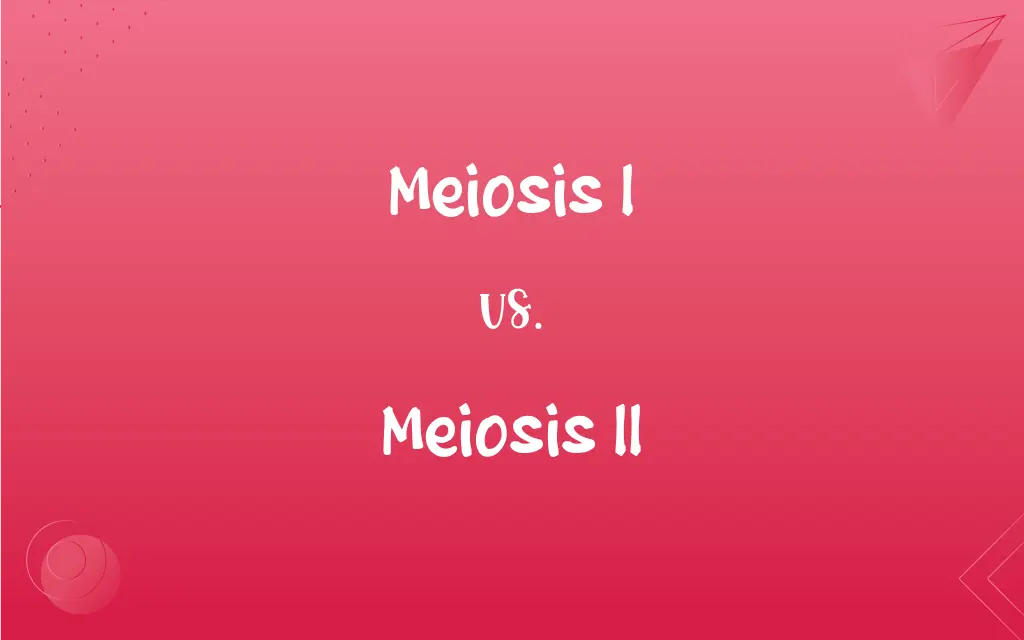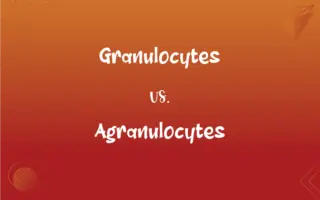Meiosis I vs. Meiosis II: What's the Difference?
Edited by Aimie Carlson || By Harlon Moss || Updated on October 30, 2023
Meiosis I reduces chromosome number by separating homologous chromosomes; Meiosis II divides sister chromatids, akin to mitosis.

Key Differences
Meiosis I is distinctive because it reduces the chromosome number by half by separating homologous chromosomes. This ensures genetic variation through recombination. In contrast, Meiosis II functions more like mitosis, focusing on the division of sister chromatids, but without duplicating the DNA.
In Meiosis I, homologous chromosomes line up and undergo genetic recombination, a process where they exchange segments. This recombination in Meiosis I leads to genetic diversity among offspring. Meiosis II, however, doesn't involve such exchanges. Instead, it ensures that each new gamete receives a complete set of chromosomes by splitting the sister chromatids apart.
One of the primary differences between Meiosis I and Meiosis II is the starting chromosome count. In Meiosis I, the cell starts as diploid, meaning it contains two sets of chromosomes. After Meiosis I, the resulting cells are haploid, containing only one set of chromosomes. Meiosis II begins with these haploid cells and ensures they're correctly divided into gametes, still maintaining the haploid state.
Furthermore, Meiosis I has subdivisions like Prophase I, Metaphase I, Anaphase I, and Telophase I, each with unique events like crossing over in Prophase I. Meiosis II, on the other hand, involves subdivisions such as Prophase II, Metaphase II, Anaphase II, and Telophase II, resembling the stages of mitosis more closely.
To sum up, Meiosis I and Meiosis II, though consecutive stages of meiosis, have distinct roles. Meiosis I ensures genetic diversity by reducing chromosome number and enabling genetic recombination, while Meiosis II is focused on the division of chromatids to produce viable gametes for sexual reproduction.
ADVERTISEMENT
Comparison Chart
Primary Function
Reduce chromosome number by separating homologous pairs.
Divide sister chromatids, similar to mitosis.
Chromosome Count at Start
Diploid (2n)
Haploid (n)
Genetic Recombination
Occurs, leading to genetic diversity.
Does not occur.
Resulting Cell
Haploid cells with separated homologous chromosomes.
Haploid cells with single chromatids from each chromosome.
Subdivisions
Prophase I, Metaphase I, etc.
Prophase II, Metaphase II, etc.
ADVERTISEMENT
Meiosis I and Meiosis II Definitions
Meiosis I
Reduces the chromosome number by half.
After Meiosis I, a diploid cell becomes two haploid cells.
Meiosis II
Second stage of meiotic cell division.
Meiosis II follows Meiosis I, ensuring proper chromosome division.
Meiosis I
Allows genetic recombination between homologous chromosomes.
Crossing over in Meiosis I contributes to genetic diversity.
Meiosis II
Resembles mitotic division.
Just like in mitosis, Meiosis II divides sister chromatids.
Meiosis I
Separates homologous chromosome pairs.
In Metaphase I of Meiosis I, homologous chromosomes align in pairs.
Meiosis II
Does not change chromosome number.
Cells remain haploid throughout Meiosis II.
Meiosis I
First stage of meiotic cell division.
During Meiosis I, homologous chromosomes separate.
Meiosis II
Ensures gametes have correct chromosome number.
After Meiosis II, each gamete has a complete haploid set of chromosomes.
Meiosis I
Results in two haploid daughter cells.
Completion of Meiosis I sets the stage for the next meiotic phase.
Meiosis II
Produces four haploid daughter cells.
Meiosis II doubles the number of cells produced in Meiosis I.
FAQs
When does genetic recombination occur in meiosis?
Genetic recombination occurs during Meiosis I.
What is the main goal of Meiosis I?
Meiosis I reduces the chromosome number by half by separating homologous chromosomes.
How many phases are in Meiosis I and II respectively?
Both have four main phases: Prophase, Metaphase, Anaphase, and Telophase.
Which meiotic phase is crucial for genetic diversity?
Meiosis I is essential for genetic diversity due to recombination.
Why is Meiosis II essential?
Meiosis II ensures that gametes have the correct number of chromosomes.
What separates in Anaphase I and Anaphase II?
In Anaphase I, homologous chromosomes separate; in Anaphase II, sister chromatids separate.
Which meiotic phase separates homologous chromosomes?
Homologous chromosomes are separated during Meiosis I.
Which meiotic stage divides sister chromatids?
Sister chromatids are divided during Meiosis II.
Why is Meiosis II termed an "equational" division?
Because chromosome number remains the same before and after Meiosis II.
How does chromosome alignment differ in Metaphase I and II?
In Metaphase I, homologous pairs align; in Metaphase II, individual chromosomes align.
Do cells undergo DNA replication between Meiosis I and II?
No, DNA replication occurs only once before Meiosis I begins.
What is the chromosome count of cells entering Meiosis II?
Cells entering Meiosis II are haploid, having half the original chromosome number.
How does Meiosis II resemble mitosis?
Meiosis II divides sister chromatids, similar to the process in mitosis.
Do both meiotic stages start with a diploid cell?
No, Meiosis I starts with a diploid cell, while Meiosis II starts with haploid cells.
How many chromosomes does a human cell have before and after Meiosis I?
Before: 46 (23 pairs); After: 23.
What ensures genetic variation in Meiosis I?
Crossing over and independent assortment ensure genetic variation.
Why is it important for gametes to be haploid?
Haploid gametes ensure that upon fertilization, the resulting zygote will have the correct diploid chromosome number.
Are chromosomes replicated before Meiosis II?
No, DNA replication occurs only once before Meiosis I.
How many daughter cells result from Meiosis II?
Meiosis II produces four haploid daughter cells.
Are the cells produced at the end of Meiosis I identical?
No, due to genetic recombination, the cells are genetically different.
About Author
Written by
Harlon MossHarlon is a seasoned quality moderator and accomplished content writer for Difference Wiki. An alumnus of the prestigious University of California, he earned his degree in Computer Science. Leveraging his academic background, Harlon brings a meticulous and informed perspective to his work, ensuring content accuracy and excellence.
Edited by
Aimie CarlsonAimie Carlson, holding a master's degree in English literature, is a fervent English language enthusiast. She lends her writing talents to Difference Wiki, a prominent website that specializes in comparisons, offering readers insightful analyses that both captivate and inform.































































